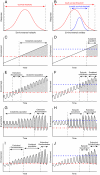Ecology and the ratchet of events: climate variability, niche dimensions, and species distributions
- PMID: 19805104
- PMCID: PMC2780932
- DOI: 10.1073/pnas.0901644106
Ecology and the ratchet of events: climate variability, niche dimensions, and species distributions
Abstract
Climate change in the coming centuries will be characterized by interannual, decadal, and multidecadal fluctuations superimposed on anthropogenic trends. Predicting ecological and biogeographic responses to these changes constitutes an immense challenge for ecologists. Perspectives from climatic and ecological history indicate that responses will be laden with contingencies, resulting from episodic climatic events interacting with demographic and colonization events. This effect is compounded by the dependency of environmental sensitivity upon life-stage for many species. Climate variables often used in empirical niche models may become decoupled from the proximal variables that directly influence individuals and populations. Greater predictive capacity, and more-fundamental ecological and biogeographic understanding, will come from integration of correlational niche modeling with mechanistic niche modeling, dynamic ecological modeling, targeted experiments, and systematic observations of past and present patterns and dynamics.
Conflict of interest statement
The authors declare no conflict of interest.
Figures



References
-
- Chase JM, Leibold MA. Ecological Niches. Chicago: Univ of Chicago Press; 2003.
-
- Soberón J. Grinnellian and Eltonian niches and geographic distributions of species. Ecol Lett. 2007;10:1115–1123. - PubMed
-
- Thuiller W, Lavorel S, Araújo MB. Niche properties and geographical extent as predictors of species sensitivity to climate change. Global Ecol Biogeog. 2005;14:347–357.
-
- Hamann A, Wang T. Potential effects of climate change on ecosystem and tree species distribution in British Columbia. Ecology. 2006;87:2773–2786. - PubMed
Publication types
MeSH terms
LinkOut - more resources
Full Text Sources
Medical
Miscellaneous

